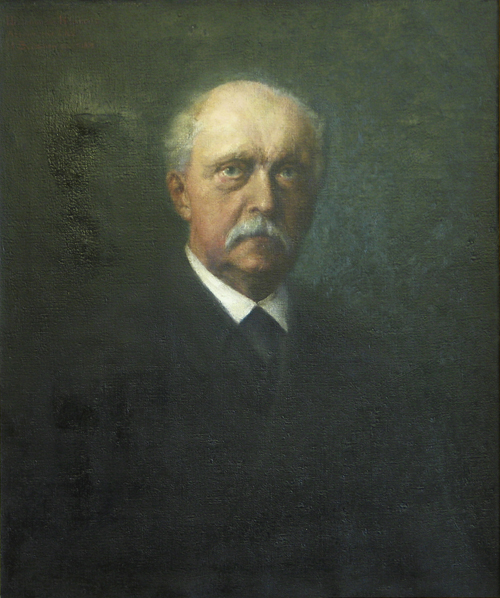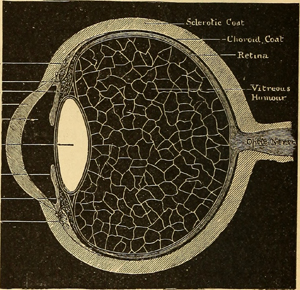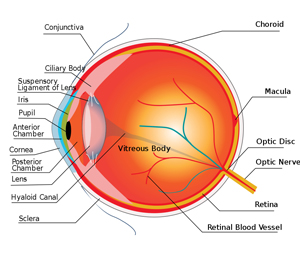
Your complimentary articles
You’ve read one of your four complimentary articles for this month.
You can read four articles free per month. To have complete access to the thousands of philosophy articles on this site, please
Brief Lives
Hermann von Helmholtz (1821-1894)
Dylan Daniel looks at the philosophical insights of a remarkable scientist.
Hermann von Helmholtz is a name that is not uttered frequently enough anymore. But this remarkable scientist, and philosopher, contributed to modern thought a veritable treasure trove of concepts and inventions. His mind had an uncanny way of attacking a problem at several levels simultaneously, yielding extraordinary results. He invented and popularized the ophthalmoscope, participated in describing non-Euclidean geometry, published across many disciplines, including physiology, psychology, physics, and philosophy, and in 1995 the Helmholtz Association of German Research Centers was created to commemorate his myriad contributions to science. Yet perhaps the greatest innovation to which Helmholtz contributed is still being developed in philosophy, psychology, and the neurosciences: a deep understanding of the human mind.

Hermann von Helmholtz by Hans Schadow, 1891
Hermann von Helmholtz was born in Potsdam, Prussia, on August 31, 1821. As a boy, he was neither particularly wealthy nor endowed with any particular social standing. His father was a high school teacher, and so young Hermann had been the beneficiary of an excellent education despite the modest means which accompanied it. He began his academic career in an army medical school, choosing to practice medicine because of the pay that came with it, in spite of his significant interest in both physics and mathematics. His M.D. thesis proved that nerve fibers allowed ganglion [brain] cells to communicate with one another, earning him both a precocious doctorate and affording him some credibility as a researcher.
In 1843 Helmholtz graduated from medical school and moved to Potsdam, where he set up a laboratory in the barracks. He married Olga von Velten at this time, but soon was discharged from the military due to his obvious gift for scientific enquiry. The couple had children two children, Richard (1852-1933) and Ellen Ida Elisabeth (1864-1941), who followed their father’s dedication to science with keen interest.
Family life for von Helmholtz was never top priority, but he displayed a keen interest in his children and loved to discuss science with them (this pattern was apparent in his friendships as well). According to Helmholtz’ son, Richard, “it was chiefly at meals and out walking that we saw him… It gave him keen pleasure to show us any natural phenomenon…” (Hermann von Helmholtz, Koenigsberger, p.221). Indeed, Helmholtz was a model citizen and father for his day, even though he focused upon science to a degree which allowed it to dominate his interactions with his family and his large network of friends.
Although he had more formal training in physiology than in physics, Helmholtz wrote On the Conservation of Force with help from the physiologist Emile du Bois-Reymond, and submitted it to the nascent Academy of Physics in Berlin in 1847. The paper was well received, proving that the understanding Helmholtz possessed of physics and mathematics was extremely advanced. Not yet even thirty, young Helmholtz had already made major contributions to both physics and physiology.
Helmholtz rose through the ranks of German academia from his initial position as a Professor of Physiology at Konigsberg (1849-55) to Bonn (1855-58), to Heidelberg (1858-71). He then began to focus upon physics, in which field he was a Professor at the University of Berlin (1871-77), and at the Military Institute for Medicine and Surgery (1877-1887). In 1887, he became the founding President of the Physicalisch-Technische Reichsanstalt in Berlin, a post he held until his death in Berlin in 1894, at the age of 73.
During his impressive career, Helmholtz held chairs in three different disciplines – physics, physiology, and anatomy – and published papers in these fields as well as in mathematics, philosophy, music theory, and aesthetics. His understanding of physics made it simple for him to conduct a measurement of the actual speed of the transmission of an action potential [an electric pulse] along a nerve fiber, which was a major contribution to the field of physiology. Prior to this test, it was believed that the speed of transmission of a nerve impulse was the speed of light; but instead of 300,000 km per second, it turned out to only be about 26.4 meters per second!
Interdisciplinary understanding – a motif in his life – is what led Helmholtz to make advancements in the sciences. And Helmholtz’ interdisciplinary excellence came from his exceptional talent for philosophical questioning and clear-minded reasoning, coupled with the means to empirically test hypotheses.
Sight, Sound and Reality
Philosophically, Helmholtz was a rather devout pupil of Immanuel Kant (1724-1804). His most significant break from Kant came in his investigation of non-Euclidean geometry. Otherwise, like Kant, he believed that space (among other things) was not a fact of the world beyond the human mind and instead has to do with our perception.
One of Kant’s central philosophical conclusions was the inaccessibility of the ‘ ding-an-sich’, or ‘thing-in-itself’ – what something (or the world) is like in itself independent of our perceptions of it. It was this concept that led Helmholtz to be interested in the neuroanatomy of perception; and his twin interests in the mechanics of sight and hearing led to some of his most remarkable scientific discoveries. Let’s have a quick look at each of Helmholtz’ major scientific phases in an attempt to learn more about the workings of the mind behind them.

Eyeball in 1890
© Charles Henry May 1890
Helmholtz developed an interest in vision at an early stage in his career, and he discovered that the living retina of the human eye is in fact pink. The black of the pupil had puzzled scientists for a long time, and it was generally accepted that this was due to the shape of the eye – the pupil, after all, is a focusing device, designed to let in light rather than let it out. However, getting a look at the living retina was a difficult proposition for exactly this reason. A need existed to peer into the eye without damaging it, and Helmholtz’ invention of the ophthalmoscope advanced optical care by satisfying this need.
During his research into this, Helmholtz became intrigued by some related questions to do with our capacity for sight. How did the retina transmit the information it received to the conscious mind? The optic nerve was the most obvious answer to this question, but upon investigating it, more questions arose. Where did the nerve impulses go? How did the mind become aware of them, giving rise to consciousness of a given visual input?
Even now, with all our technological advances, there is not yet a complete account of the brain’s generation of consciousness. Yet we know a lot. We know now for example that the fatty sheath encasing each nerve fiber has breaks in it every so often which allow potassium and sodium ions to interact, providing a chemical reaction which propels an electric current along the fiber until it reaches the end, the synapse of a neuron, where it causes the release of neurotransmitter chemicals. This either encourages the next neuron in the sequence to fire a pulse, or inhibits it from doing so. We also know that the area for the processing of visual information is at the back of the brain.
After visual perception, Helmholtz’ next natural subject of inquiry was auditory perception. Helmholtz studied the cochlea of the inner ear in great detail, at first fascinated by the ridges within it. Later, his attention turned to the fine hairs which lined the interior of the organ. This interest once again had a lasting impact upon human understanding. Hearing, as we know today, is caused by vibrations being picked up precisely by these small hairs. Information concerning these vibrations is then (again) transmitted by nerves to specific areas in the brain.

Eyeball in 2018
© Hariadhi 2017
However, from a philosophical perspective, perhaps the most interesting aspect of each of these anatomical accounts of the acquisition of sense-data is what they lack. None of them involves anything from the outside world making it into the brain, or even getting closer to it than mere contact with a nerve ending. This even Helmholtz knew. And as both Helmholtz’ audio and visual perception research revealed ways to fool the senses, this further supported a gap between external objects and the mind perceiving them. Helmholtz was eventually led to argue that perceptions are signs rather than objective accounts of the data taken in. Indeed, for him the world had faded away from immediate access, and what was left in the mind was a mental model of the world (including a model of the body) which allowed actions to be taken and consequences to be evaluated. The effect of prior action as observed via the senses, when incorporated into our mental model, shaped our future action. And practice at a musical instrument, for example, allowed the mental model to be more effectively mapped onto the body, so that playing an instrument became easier and the music sounded better.
This was a bit of a tough pill to swallow for some philosophers. It is entirely likely that a fair amount of Helmholtz’ disdain for philosophy came from the skeptical attitude he attracted from philosophers who preferred to argue about conceptual issues while neglecting the empirical discoveries he was making. However, philosophical thought was behind a great deal of the scientific achievement Helmholtz produced during his life, and continues to play a major role in the field to which his work helped give rise – that of neuroscience. Indeed, in the light of his deep grasp of these complex phenomena, it might be fair to call Helmholtz ‘the father of neuroscience’.
Helmholtz’ Mental Life
In his book Descartes’ Error (1994), the neuroscientist Antonio Damasio poked holes in Cartesian Dualism. Descartes’ famous theory is basically a vision of the physical human body as being controlled by a non-physical soul or mind which is fundamentally separate from it. He believed the mind interacts with the body through the brain’s pineal gland, a position long since scientifically invalidated. For Damasio, cognitive neuroscience has now removed the various elements of thought from the black box of ‘mind’ and placed them in the body, where a clear and verifiable account of their workings is easily accessible. We are familiar with some components of the body, such as muscles, bones, hearts and lungs and livers, but other parts still mystify us, particularly the brain. The staggeringly difficult problem of tracing the functional connectivity in the brain provides little in the way of yielding elegant verifiable accounts useful for the details of the inner workings of consciousness. In this situation, the Kantian insight developed by Helmholtz is still very cutting-edge. Even Damasio might agree with Helmholtz’ idea that minds map our bodies and generate mental images of ourselves and the world around us by constantly recording and comparing images (percepts) generated by neuronal interactions.
The key to this understanding came from Kant’s distinction between appearance and reality. Helmholtz then used his physiological knowledge to update Kant’s thinking to say that although we have no direct access to the thing-in-itself, we do receive information about it which allows our brains to update the model our minds have of it, and so the world. Research into the workings of the senses and nerve fibers allowed Helmholtz to construct this theory, just as today cognitive neuroscientists test and research various ideas related to it. Modern cognitive neuroscience has so far been unable to improve on his observation that “Inductive inferences, as acquired by the unconscious work of memory, play a prominent part in the building up of concepts” (Koenigsberger, p.428). This seminal idea of the influence of the unconscious on the brain’s construction of our thought is (again) the direct offspring of the philosophy of Immanuel Kant and the science of Hermann von Helmholtz.
Perhaps Helmholtz’ most remarkable intellectual feat was his characterisation of the human brain as a ‘prediction machine’. In modern times, Kent Berridge and Terry Robinson have done incredible research into the physical mechanisms of human motivation, looking at dopamine-sensitive neurons which are involved in predicting a given action’s outcome. These neurons increase or decrease their activation level in future situations based upon the accuracy of their latest prediction, thus continually improving the accuracy with which we can make predictions. This gives us some empirical evidence affirming Helmholtz’ prediction machine idea.
Philosophy as a Source for Science
For me the most interesting aspect of Hermann von Helmholtz’s life is the extent to which he borrowed from philosophy to inform ground-breaking, awe-inspiring scientific studies in a variety of disciplines. It is as though his gifted mind decided at an early age to test Kant’s problem-set in any ways possible, and the rest of his studies were a natural consequence of this interest. From the concept of an unconscious inference of ideas, to the physiological study which fleshed out his ideas of perception, Helmholtz was an example of excellence in philosophy as well as science.
Helmholtz seems to have suffered a stroke at the end of his career, which led to a period of dementia that lasted about two months until September 8, 1894, when the brilliant man finally died. “His early death… was felt not merely as an irreparable loss to science, but as a national misfortune,” wrote his long-term friend, Emil du Bois-Reymond.
Although his physics has been partly pushed aside by Einstein, Helmholtz’ ideas have shaped and molded modern science, and his insights have made profound impressions upon many of the greatest thinkers of the past hundred and fifty years. By understanding the philosophy of perception, Helmholtz was able to gain an unprecedented level of insight into the mind doing the perceiving, via means both theoretical and empirical. Now, over a hundred years after his death, science is beginning to allow researchers to test some of his most brilliant insights.
© Dylan Daniel 2018
Philosopher and writer Thomas Dylan Daniel graduated from Texas State University with an MA in Applied Philosophy and Ethics. His book Formal Dialectics is available now at cambridgescholars.com/formal-dialectics. Enter code DIALECTICS20 to receive a special discount!









